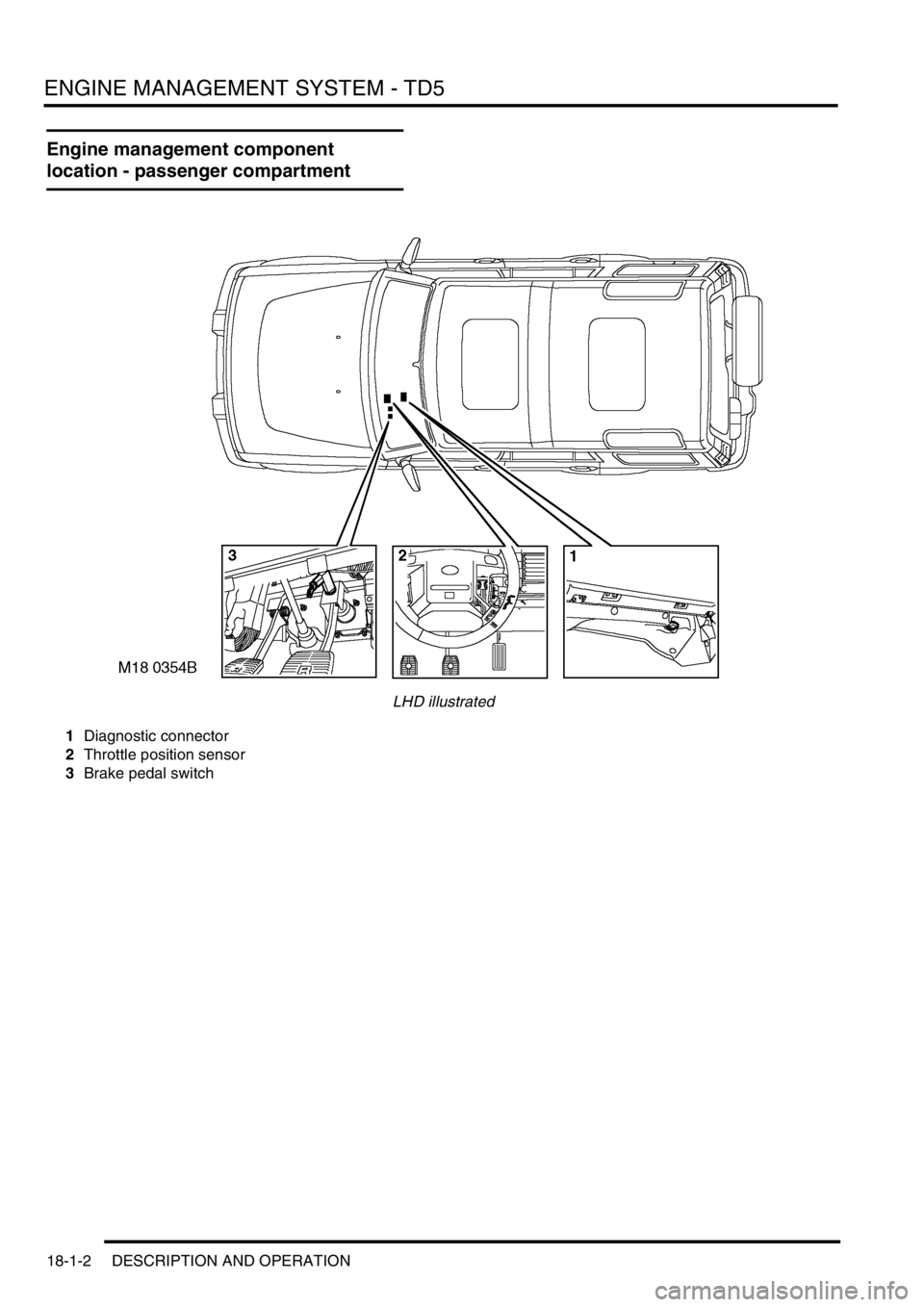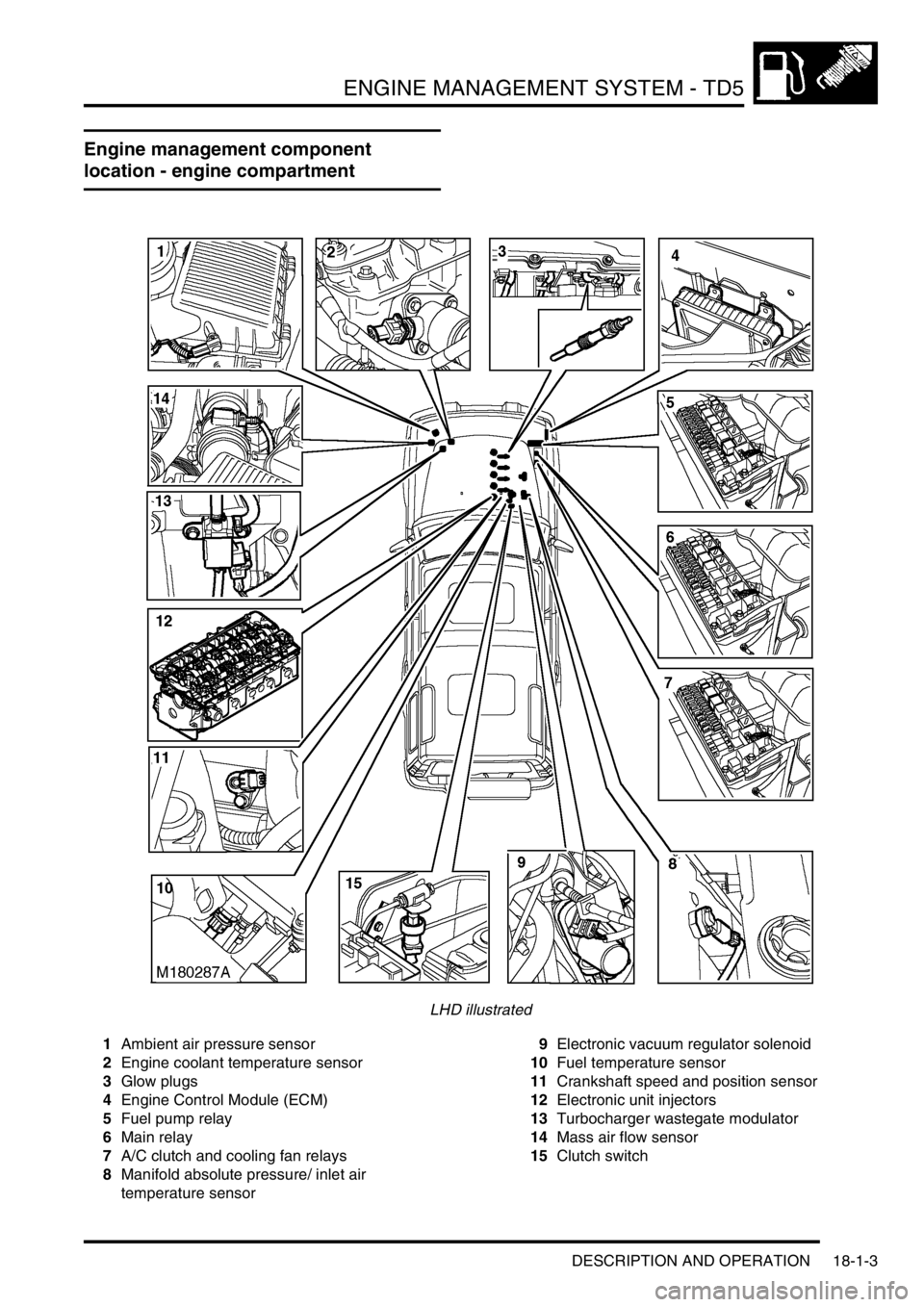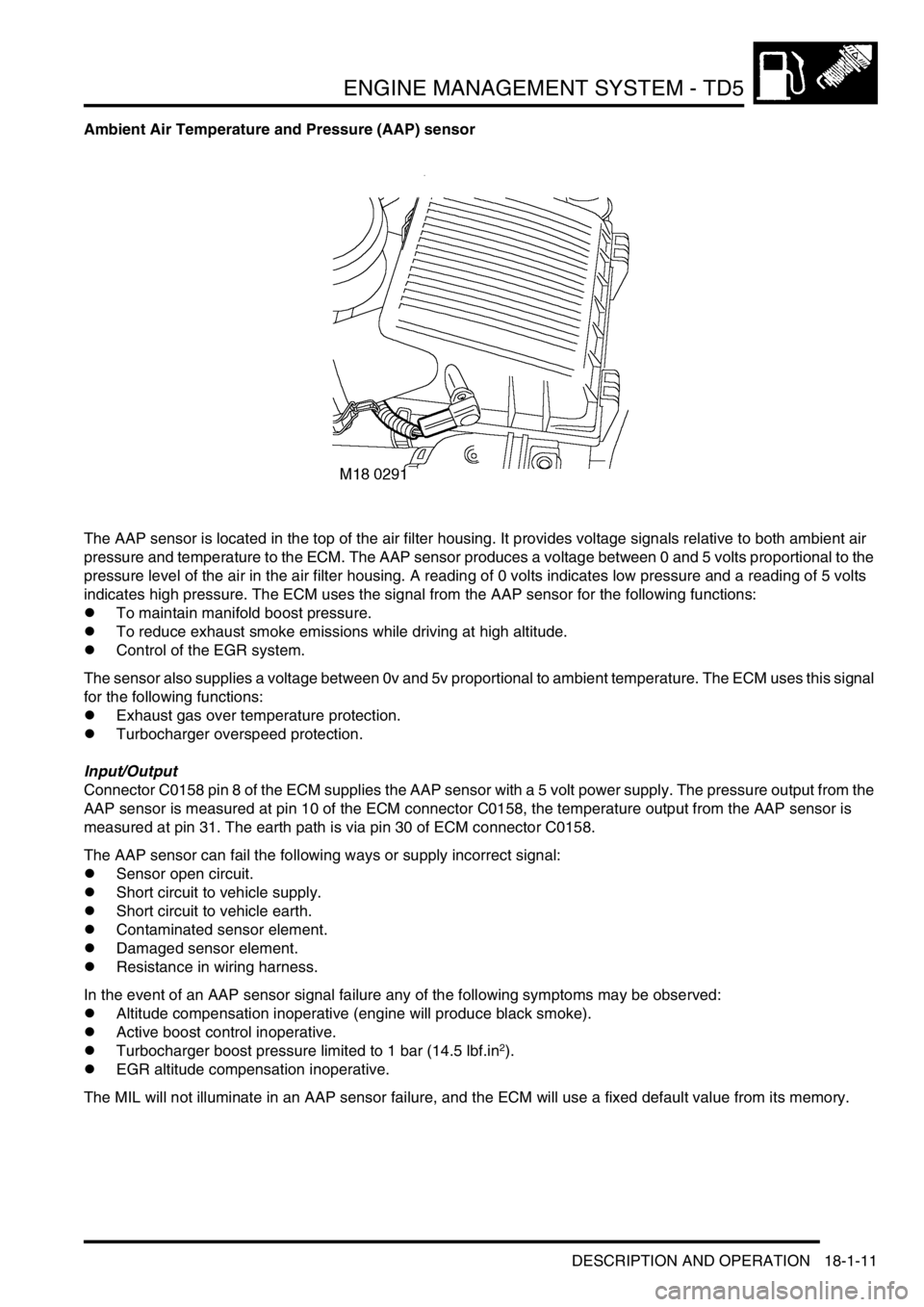sensor LAND ROVER DISCOVERY 2002 Manual PDF
[x] Cancel search | Manufacturer: LAND ROVER, Model Year: 2002, Model line: DISCOVERY, Model: LAND ROVER DISCOVERY 2002Pages: 1672, PDF Size: 46.1 MB
Page 385 of 1672

EMISSION CONTROL - V8
17-2-48 REPAIRS
Sensor - heated oxygen (HO2S) - post-
catalytic converter
$% 19.22.17
Remove
1.Raise vehicle on ramp.
2.Release HO
2S multiplug from support bracket.
3.Disconnect HO
2S multiplug from harness.
4.Using a 22 mm crowsfoot spanner, remove
HO
2S.
CAUTION: HO2 sensors are easily damaged
by dropping, excessive heat or
contamination. Care must be taken not to
damage the sensor housing or tip.Refit
1.Clean sensor and exhaust pipe mating
surfaces.
2.If refitting existing sensor, apply anti-seize
compound to sensor threads.
WARNING: Some types of anti-seize
compound used in service are a health
hazard. Avoid skin contact.
NOTE: A new HO2 sensor is supplied pre-
treated with anti-seize compound.
3.Fit a new sealing washer to HO
2S
4.Fit HO
2S and tighten to 45 Nm (33 lbf.ft).
5. Connect HO
2S multiplug to harness and fit
harness to bracket.
6.Secure harness to clip.
7.Lower vehicle.
Page 395 of 1672

ENGINE MANAGEMENT SYSTEM - TD5
18-1-2 DESCRIPTION AND OPERATION
Engine management component
location - passenger compartment
LHD illustrated
1Diagnostic connector
2Throttle position sensor
3Brake pedal switch
Page 396 of 1672

ENGINE MANAGEMENT SYSTEM - TD5
DESCRIPTION AND OPERATION 18-1-3
Engine management component
location - engine compartment
LHD illustrated
1Ambient air pressure sensor
2Engine coolant temperature sensor
3Glow plugs
4Engine Control Module (ECM)
5Fuel pump relay
6Main relay
7A/C clutch and cooling fan relays
8Manifold absolute pressure/ inlet air
temperature sensor9Electronic vacuum regulator solenoid
10Fuel temperature sensor
11Crankshaft speed and position sensor
12Electronic unit injectors
13Turbocharger wastegate modulator
14Mass air flow sensor
15Clutch switch
Page 398 of 1672

ENGINE MANAGEMENT SYSTEM - TD5
DESCRIPTION AND OPERATION 18-1-5
1Mass air flow sensor
2Ambient air pressure sensor
3Manifold absolute pressure/ inlet air
temperature sensor
4Engine coolant temperature sensor
5Crankshaft speed and position sensor
6Throttle position sensor
7Fuel temperature sensor
8Brake pedal switch
9Clutch switch
10High/ Low ratio switch
11Main relay
12Malfunction indicator lamp
13Fuel pump relay
14Glow plug warning lamp
15Glow plugs16Electronic unit injectors
17Turbocharger wastegate modulator
18EGR modulator
19Diagnostic connector
20Engine control module
21Cruise control master switch
22Cruise control SET+ switch
23Cruise control RES switch
24Air conditioning clutch relay
25Air conditioning cooling fan relay
26Electronic automatic transmission ECU
27Self levelling and anti-lock brakes ECU
28Instrument cluster
29Body control unit
Page 399 of 1672

ENGINE MANAGEMENT SYSTEM - TD5
18-1-6 DESCRIPTION AND OPERATION
Description
General
An engine control module (ECM) controls the five-cylinder direct injection diesel engine, and works on the drive by
wire principle. This means there is no throttle cable, the ECM controls the drivers needs via a signal from the Throttle
Position (TP) sensor on the throttle pedal.
The ECM is a full authoritative diesel specific microprocessor that also incorporates features for cruise control and air
conditioning control. In addition, the ECM supplies output control for the exhaust gas recirculation and turbocharger
boost pressure. The ECM has a self-diagnostic function, which is able to provide backup strategies for most sensor
failures.
The ECM processes information from the following input sources:
lMass air flow sensor.
lAmbient air pressure sensor.
lManifold absolute pressure/inlet air temperature sensor.
lEngine coolant temperature sensor.
lCrankshaft speed and position sensor.
lThrottle position sensor.
lFuel temperature sensor.
lAir conditioning request.
lAir conditioning fan request.
lBrake pedal switch.
lClutch switch.
lCruise control master switch.
lCruise control SET+ switch.
lCruise control RES switch.
lHigh/low ratio switch.
The input from the sensors constantly updates the ECM with the current operating condition of the engine. Once the
ECM has compared current information with stored information within its memory, it can make any adjustment it
requires to the operation of the engine via the following:
lAir conditioning clutch relay.
lAir conditioning cooling fan relay.
lElectronic vacuum regulator solenoid.
lMalfunction indicator lamp.
lFuel pump relay.
lGlow plug warning lamp.
lGlow plugs.
lFuel injectors.
lMain relay.
lTurbocharger wastegate modulator.
lTemperature gauge.
The ECM interfaces with the following:
lElectronic Automatic Transmission (EAT).
lSelf Levelling and Anti-lock Brakes System (SLABS).
lSerial communication link.
lInstrument cluster.
lBody Control Unit (BCU).
Page 400 of 1672

ENGINE MANAGEMENT SYSTEM - TD5
DESCRIPTION AND OPERATION 18-1-7
Engine Control Module (ECM)
The ECM is made from aluminium alloy and is located in the engine compartment on the RH side inner wing. The
ECM has an interface of 72 pins via two connectors providing both input information and output control. The ECM
receives information from the sensors to inform it of the current state of the engine. The ECM then refers this
information to stored values in its memory and makes any changes to the operation of the engine as necessary via
the actuators. This is a rolling process and is called adaptive strategy. By using this adaptive strategy the ECM is
able to control the engine to give optimum driveability throughout all operating conditions. There is no ECM self test,
although the ECM saves driveability data from the last journey. Power down of the ECM can take between 10 seconds
and 10 minutes dependent on coolant temperature.
Page 401 of 1672

ENGINE MANAGEMENT SYSTEM - TD5
18-1-8 DESCRIPTION AND OPERATION
Input/Output
ECM inputs and outputs are detailed below:
Connector C0158
Pin No. Input/Output Function Signal type Value Interfaces
A1 Output Injector 5 Analogue 0
A2 Not used
A3 Output EGR modulator Digital 0-12
A4 Not used
A5 Input FT sensor earth 0 volts 0
A6 Input MAP sensor Analogue 0-5 volts
A7 Input ECT sensor Analogue 0-5 volts
A8 Sensor supply Sensor supply 5 volts 5 volts
A9 HT pin
A10 Input AAP sensor Analogue 0-5 volts
A11 Input MAF sensor Analogue 0-5 volts
A12 Not used
A13 Input CKP sensor positive Analogue
A14 Not used
A15 Input Sensor earth 5 0 volts 0 volts
A16 Input CKP sensor screened earth 0 volts 0 volts
A17 Input Sensor earth 6 0 volts 0 volts
A18 Input Sensor earth 3 0 volts 0 volts
A19 Input FT sensor Analogue 0-5 volts
A20 Input Sensor earth 2 0 volts 0 volts
A21 Output Turbocharger wastegate
modulatorDigital 0-12 volts
A22 Output Injector common 2 Analogue 0-85 volts
A23 Output Injector common 1 Analogue 0-85 volts
A24 Output Injector 4 Analogue 0 volts
A25 Output Injector 1 Analogue 0 volts
A26 Output Injector 2 Analogue 0 volts
A27 Output Injector 3 Analogue 0 volts
A28 Not used
A29 Output Glow plug relay Analogue 0-90 volts
A30 Input Sensor earth 4 0 volts 0 volts
A31 Not used
A32 Input/Output CAN negative Digital 2.5-5 volts EAT
A33 Input High/low ratio switch Digital 0-5 volts EAT, SLABS
A34 Input IAT sensor Analogue 0-5 volts
A35 Input/Output Can positive Digital 2.5-5 volts EAT
A36 Input CKP sensor negative 0 volts 0 volts
Page 402 of 1672

ENGINE MANAGEMENT SYSTEM - TD5
DESCRIPTION AND OPERATION 18-1-9
Connector C0658
Pin No. Input/Output Function Signal type Value Interfaces
B1 Input Earth 1 0 volts 0 volts
B2 Input Earth 4 0 volts 0 volts
B3 Input Supply battery voltage 12 volts 12 volts
B4 Output Cooling fan relay Switch 12-0 volts A/C ECU
B5 Output Fuel pump relay Switch 12-0 volts
B6 Output MIL Switch 12-0 volts Instruments
B7 Output Temperature gauge Digital 0-12 volts Instruments
B8 Not used
B9 Input A/C clutch request Switch 12-0 volts A/C ECU
B10 Input Normally closed brake
switchSwitch 12-0 volts
B11 Input Cruise control SET+ switch Switch 12-0 volts
B12 Input TP sensor 1 Analogue 0- 5 volts
B13 Input Vehicle speed Digital 0-12 volts
B14 Input TP sensor supply 5 volts 5 volts
B15 Input Cruise control master switch Switch 12-0 volts
B16 Input Normally open brake switch Switch 0-12 volts
B17 Input Cruise control RES switch Switch 12-0 volts
B18 Input/Output Serial communication link Digital 0-12 volts All ECU's
B19 Output Tachometer engine speed Digital 0-12 volts Instrument
Cluster
B20 Not used
B21 Output Main relay Switch 0-12 volts
B22 Input Supply battery voltage 12 volts 12 volts
B23 Input A/C fan request Switch 12-0 volts
B24 Input Earth 3 0 volts 0 volt
B25 Input Earth 2 0 volts 0 volts
B26 Input TP sensor earth 0 volts 0 volts
B27 Input Supply 2 12 volts 12 volts
B28 Not used
B29 Output A/C relay Switch 12-0 volts
B30 Output Glow plug warning light Switch 12-0 volts Instrument
Cluster
B31 Not used
B32 Output ABS digital 0-5 volts SLABS
B33 Input Ignition Switch 0-12 volts
B34 Input Security code digital 0-5 volts
B35 Input Clutch switch Switch 12-0 volts
B36 Input TP sensor 2 Analogue 5-0 volts
Page 403 of 1672

ENGINE MANAGEMENT SYSTEM - TD5
18-1-10 DESCRIPTION AND OPERATION
Mass Air Flow (MAF) sensor
The MAF sensor is located in the intake system between the air filter housing and the turbocharger. The ECM uses
the information generated by the MAF to control exhaust gas recirculation (EGR).
The MAF sensor works on the hot film principal. The MAF sensor has 2 sensing elements contained within a film. One
element is controlled at ambient temperature e.g. 25
°C (77 °F) while the other is heated to 200 °C (392 °F) above
this temperature e.g. 225
°C (437 °F). As air passes through the MAF sensor the hot film will be cooled. The current
required to keep the constant 200
°C (392 °F) difference provides a precise although non-linear signal of the air drawn
into the engine. The MAF sensor sends a voltage between 0 and 5 volts to the ECM proportional to the mass of the
incoming air. This calculation allows the ECM to set the EGR ratio for varying operating conditions.
Input/Output
The MAF sensor receives battery voltage from the main relay in the engine compartment fuse box. Signal output from
the MAF sensor to the ECM is a variable voltage proportional to air drawn into the engine.
Input to the MAF sensor is via pin 5 of connector C0570 at the engine compartment fuse box. This 12 volt supply is
provided by the main relay via fuse 2 in the engine compartment fuse box. The MAF sensor receives the input voltage
at pin 3 of the sensor connector.
Output from the MAF sensor is measured at pin 11 of the ECM connector C0158. The earth path is via pin 20 of the
ECM connector C0158.
The MAF sensor can fail the following ways or supply incorrect signal:
lSensor open circuit.
lShort circuit to vehicle supply.
lShort circuit to vehicle earth.
lContaminated sensor element.
lDamaged sensor element.
lDamaged in wiring harness.
lMAF supplies incorrect signal (due to air leak or air inlet restriction).
In the event of a MAF sensor signal failure any of the following symptoms may be observed:
lDuring driving engine speed may dip, before recovering.
lDifficult starting.
lEngine stalls after starting.
lDelayed throttle response.
lEGR inoperative.
lReduced engine performance.
lMAF signal out of parameters.
The MIL will not illuminate in a MAF sensor failure, and the ECM will use a fixed default value from its memory.
Page 404 of 1672

ENGINE MANAGEMENT SYSTEM - TD5
DESCRIPTION AND OPERATION 18-1-11
Ambient Air Temperature and Pressure (AAP) sensor
The AAP sensor is located in the top of the air filter housing. It provides voltage signals relative to both ambient air
pressure and temperature to the ECM. The AAP sensor produces a voltage between 0 and 5 volts proportional to the
pressure level of the air in the air filter housing. A reading of 0 volts indicates low pressure and a reading of 5 volts
indicates high pressure. The ECM uses the signal from the AAP sensor for the following functions:
lTo maintain manifold boost pressure.
lTo reduce exhaust smoke emissions while driving at high altitude.
lControl of the EGR system.
The sensor also supplies a voltage between 0v and 5v proportional to ambient temperature. The ECM uses this signal
for the following functions:
lExhaust gas over temperature protection.
lTurbocharger overspeed protection.
Input/Output
Connector C0158 pin 8 of the ECM supplies the AAP sensor with a 5 volt power supply. The pressure output from the
AAP sensor is measured at pin 10 of the ECM connector C0158, the temperature output from the AAP sensor is
measured at pin 31. The earth path is via pin 30 of ECM connector C0158.
The AAP sensor can fail the following ways or supply incorrect signal:
lSensor open circuit.
lShort circuit to vehicle supply.
lShort circuit to vehicle earth.
lContaminated sensor element.
lDamaged sensor element.
lResistance in wiring harness.
In the event of an AAP sensor signal failure any of the following symptoms may be observed:
lAltitude compensation inoperative (engine will produce black smoke).
lActive boost control inoperative.
lTurbocharger boost pressure limited to 1 bar (14.5 lbf.in
2).
lEGR altitude compensation inoperative.
The MIL will not illuminate in an AAP sensor failure, and the ECM will use a fixed default value from its memory.